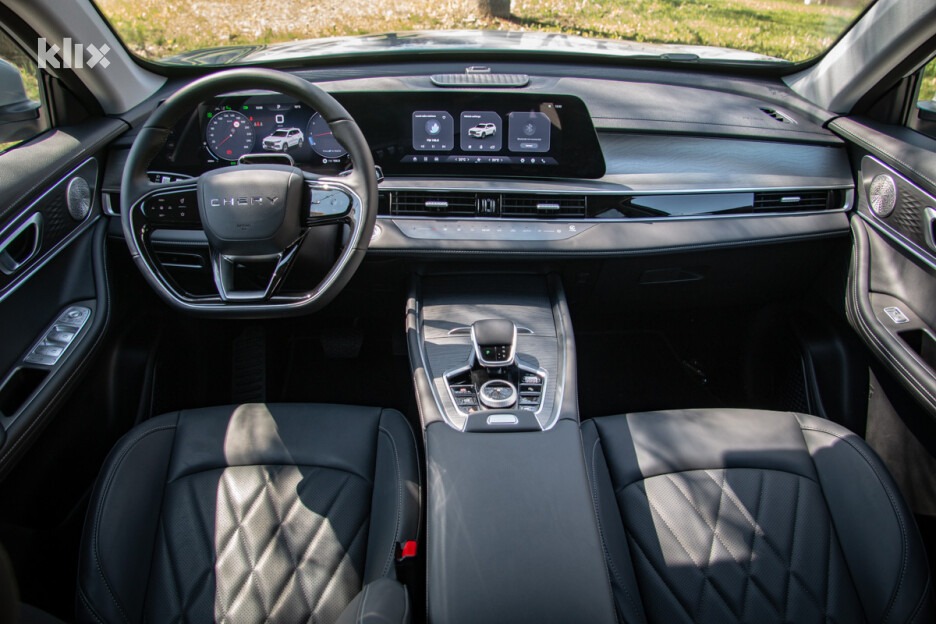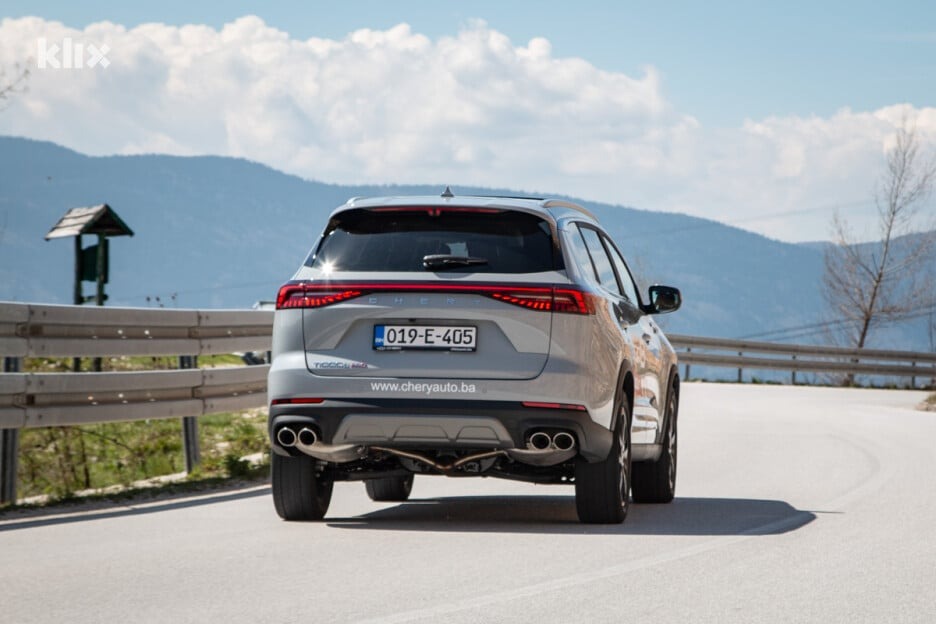While we wait for their largest SUV model, the Tiggo 9, we tested a decently redesigned edition of the well-equipped D-segment SUV that Chinese car company Chery offers under the name Tiggo 8 Pro. Seven days later, we unanimously concluded that the “Eight”, which can accommodate seven people, has convincingly shattered prejudices about cars from China.
Yes, we thought that someone for the Chinese company Chery (which does not sell cherries or is not named after them) could have designed a much more original logo that would not look like the logo of the luxury sub-brand of Nissan that hides behind the name Infiniti, but we did not think that one of the five or six Chinese car companies that are present (and) on our market would have an SUV from the D segment that brings with it much more than an attractive price for which those responsible at Chery would then have a basis for justification any shortcomings.
There is no such thing here, so we concluded that European car manufacturers, because at the moment Europeans value their money more and more, in the foreseeable future could have more and more problems in convincing the mentioned buyers that their cars are worth paying significantly more than for the dimensions and equipment of comparable models offered by a few Chinese car companies that have come out on the international scene in a big way.

Among them is the company Chery, which is doing great for now, because they have sold close to 14 million cars since entering the markets outside of China, which is not strange if we remember the ratio invested/received, which is also transparent in the case of Chery’s recently redesigned SUV Tiggo 8 Pro, which comes with three rows of seats and a lot of equipment.
A look at the 4.7-meter-long body should be the first step in dispelling prejudices and doubts about Chinese cars, for which the Chinese semi-products that arrived in Bosnia and Herzegovina in the post-war period are mostly to blame, because the Tiggo 8 Pro looks quite decent from all angles. A ready-made product that, without the manufacturer’s inscription, could be Japanese, South Korean, or even European, which is supported by the design of the housing of the front and rear LED lights.
Without unnecessary design acrobatics, which are often counterproductive, Tiggo seemed much more acceptable to our eyes than several models produced by (non)Chinese companies. The finishing touch is the design of the two-tone 19-inch alloy wheels. There are additionally tinted windows behind the B-pillars, and we liked the active quad exhaust tips that, along with the red letter T on the front fenders, might make less automotive connoisseurs think that the Tiggo is powered by a much bigger engine with a lot more “horses”.
Due to the pronounced distance between the floor and the ground, it is a shame that we do not sell the 8 Pro Max version, which comes with a larger two-liter turbo gasoline engine and drive through both axles, because with drive through the front axle and without any electronic aids for torque distribution, the test specimen faltered in certain situations on unpaved surfaces that would have been painless for it with integral drive.
That the Chinese really are not joking is best seen behind the large doors. With the rich equipment package (Luxury), buyers can count on leather-covered seats and a lot of standard equipment in a spacious and solidly insulated cabin in dark tones, which is covered with fairly high-quality materials, and can accommodate seven people. Regardless of the longitudinal movement of the second-row seats, accessing the third-row seats requires a bit of gymnastics, and the space offered on the rear axle can only offer enough comfort for children and short adults. With all seats in use, as with others, an adequate roof box will be needed for luggage, because behind the third-row backrests there is a luggage compartment that will fit less than 200 liters. If they are not needed, the third-row seats, whose backrests are then “fused” with the trunk floor, provide plenty of space for luggage.
With the latest redesign, a wide 24.6-inch one-piece display has arrived, which is divided into a transparent adaptive instrument panel behind a multifunctional leather-covered steering wheel and a multimedia system, under which there are additional buttons for controlling the air conditioning. Considering the light background, instead of white, it would be more transparent if the color on the icons of the mentioned “touch” keys was black. As part of the fairly intuitive multimedia system that is connected to the Android Auto and Apple CarPlay applications, there is also the adjustment of many systems for assistance and active safety support. We simply turned off the irritating ones.

The duo on the electrically adjustable/heated front seats can count on many useful compartments for small items, a comfortable/wide armrest and a platform for wireless charging of mobile phones, and the comfort of passengers in the second row is also contributed by the adjustment of the seatback angle. The large electrically operated glass roof also contributes to the airiness, and in Chery they took care of compartments, connectors and separate air conditioning for two people in the third row. The fifth door is also electrically operated.
As others do, so do Chery. The high-quality audio system with eight speakers is “signed” by Sony, and more importantly, behind the smooth 7-speed automatic transmission with two clutches that works flawlessly is the German company Getrag, whose gearboxes are also used by some European car manufacturers whose models are, as a rule, much more expensive than Chery’s.
The gearbox manages the potential and torque of the 1.6-liter four-cylinder turbo-petrol engine, which develops 147 horsepower instead of 186 in the damped version (due to exhaust gas emissions). In addition to the fact that at certain moments it seemed to us that the power was reduced only on paper, the cheerful engine with 273 Nm of torque manages solidly in all situations in an environment that exceeds two tons with passengers.

With a more pronounced noise that reaches the passengers only near the red working area on the tachometer, the four-cylinder product of Chery and the Austrian company AVL can be satisfied with less than seven liters per 100 kilometers at a leisurely pace on an unladen open road, and the start/stop system and the Eco working program will help it not to waste fuel even in the city. In addition to the Sport working program, with which it takes more revolutions to change gear, there is also the Normal working program that will optimally respond to all requirements on the open road. What does not work in Chery’s favor is the fact that most of the numerous competitors offer multiple drive solutions, including hybrid and diesel options.
With a softer suspension, whose primary task is to ensure a high level of comfort along with luxuriously proportioned/upholstered seats, comes moderate body roll in a more dynamic rhythm through bends, which bothers most similarly designed cars, but here too it did not affect maintaining the desired trajectory. We were more bothered by the torque distribution, which, with slightly stronger pressure on the accelerator pedal when starting off, contributed to the front wheels spinning in neutral.
The seriousness of Chery is also confirmed by the seven-year warranty with which there is not even a mileage limit in some markets, and anyone who is not immune to prejudices and doubts could be helped by the fact that for 66,000 KM from European, Japanese and South Korean manufacturers, they do not even need to ask for an SUV from the D segment with the level of equipment that comes with the harmonious Tiggo 8 Pro, because for such a story with the mentioned manufacturers, you need to allocate significantly more money.
- Basic information about the test car: Chery Tiggo 8 Pro Luxury
- Price of the test model: 66,000 KM
- Engine: Four-cylinder, petrol, transversely mounted at the front. Displacement 1,598 cc, turbocharged, direct injection, intercooler, four valves per cylinder. Maximum power 108 kW – 147 hp at 5,000 rpm. Maximum torque 273 Nm from 1,750 to 2,750 rpm.
- Power transmission: Front-axle drive. 7-speed dual-clutch automatic transmission. 19-inch alloy wheels, 235/55 R19 105V tires (Dunlop Winter Sport 5 SUV).
- Performance and fuel consumption: Acceleration from 0 to 100 km/h – 9.1 s. Maximum speed – 190 km/h. Test consumption – from 6.9 to 8.9 l/100 km. Factory declared average consumption: 7.5 l/100 km. Fuel tank volume – 57 l. Average CO² emission – 171 g/km. Euro6.
- Dimensions: Length – 4,722 mm. Width – 1,860 mm. Height – 1,705 mm. Wheelbase – 2,710 mm. Trunk volume – from 193 to 1,930 liters. Unladen weight – 1,704 kg. Total permitted vehicle weight – 2,275 kg.
- Standard equipment: Chery Tiggo 8 Pro Luxury
- Warranty: 7 years or 150,000 km.